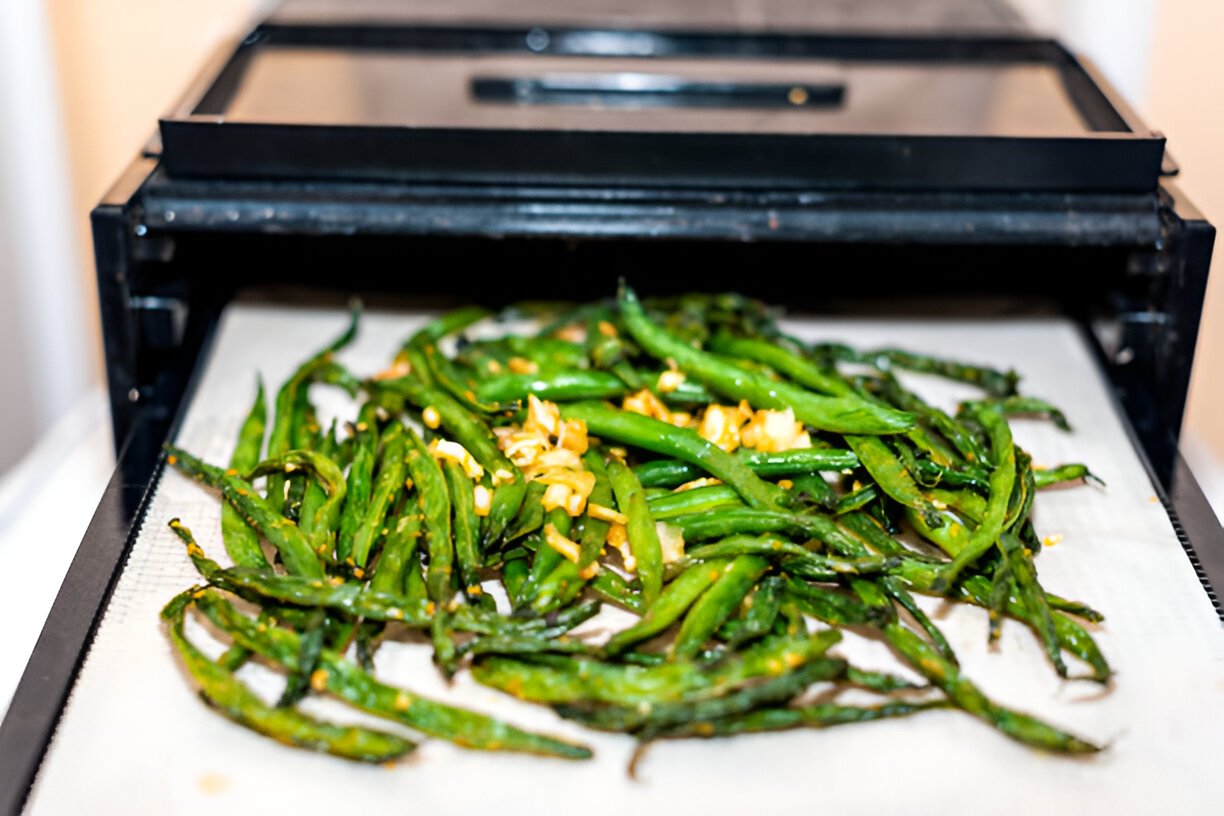How to Dehydrate Green Beans: Preserve Your Beans the Right Way
Are you looking to savor the tasty flavor of green beans throughout the year? A straightforward method to maintain their taste and crunchy texture is through dehydration.
I remember the first time I tried this. It seemed tough initially, but surprisingly, it becomes quite easy as you get the hang of it.
Today, I’ll show you step-by-step how to dehydrate green beans using an easy method that anyone can follow. So, keep reading.
Understanding Dehydrating Green Beans
Dehydrating green beans is an excellent way to extend their shelf life while preserving nutrients. Unlike freezing or canning, dehydration removes moisture, preventing bacterial growth and spoilage.
This method keeps key vitamins and minerals intact. So, you get a nutrient-rich, shelf-stable ingredient for later use. Dehydrated green beans are lightweight and save storage space. This makes them perfect for camping and emergency food supplies.
Compared to other preservation methods, dehydration has distinct advantages. Freezing keeps texture but needs steady electricity. Canning changes flavor and uses heavy jars. Dehydrated green beans, on the other hand, retain much of their natural taste and require no refrigeration.
| Preservation Method | Storage Needs | Nutrient Retention | Shelf Life |
| Freezing | Freezer space | High | 8–12 months |
| Canning | Pantry space | Moderate | 1–2 years |
| Dehydration | Minimal space | High | 1–5 years |
Dehydrating green beans gives you a handy, long-lasting option. You can use them for soups, stews, and snacks!
5 Simple Steps To Dehydrate Green Beans
1. Blanching
Begin by blanching your green beans. Boil a pot of water, include a dash of salt, and soak the beans for 2-3 minutes.
“Life expectancy would grow by leaps and bounds if green vegetables smelled as good as bacon.”
– Doug Larson, Columnist and Editor
Dipping in boiling water boosts flavor and speeds up dehydration by removing extra moisture.
2. Cool & Dry
After blanching, promptly transfer the beans into a bowl of ice water [1] to stop cooking.
Once cooled, drain the beans thoroughly and gently pat them dry using a clean paper towel.
3. Dehydrator Or Oven
Set your food dehydrator or oven to 125 degrees Fahrenheit. If your oven doesn’t go that low, use its lowest setting.
Place the blanched and dried beans on a cookie sheet or dehydrator trays, ensuring they are evenly spread out. Allow them to dehydrate for approximately 6-8 hours.
4. Proper Storage
First, dry your green beans well. Then, put them in an airtight container. Store it in a cool, dark place. This helps keep their freshness and flavor for a longer time.
5. Adjust To Taste
If you plan to eat the dehydrated beans as a snack soon, you can dry them for a shorter time. This keeps some moisture based on what you like.
Dehydration & Cooking Tips For Green Beans

- Cooking Adjustments: If you add dehydrated green beans to casseroles, stews, or soups, add extra water or stock. This makes up for how beans soak up flavor while cooking. Your dishes stay tasty and balanced.
- Oven Drying: Remember that conventional ovens may not maintain consistent low temperatures. Therefore, drying times can vary between ovens. Check your beans after approximately 8 hours until they reach your desired dryness.
- Rehydration: You have two options to bring your dehydrated green beans back to life. First, you can soak them in hot water for about an hour. You can also use the cold water method. Just soak the beans for two hours. This rehydration step ensures they regain their plumpness and tenderness.
Do Dehydrated Green Beans Taste Good?
Yes, dehydrated green beans are light and dry. They still have a great taste that can surprise your taste buds!
These dried counterparts offer a unique combination of sweet, mildly earthy, and vegetal flavors.
Dehydration takes away moisture, which boosts the natural flavor of raw green beans. This process turns them into a tasty snack or a flexible ingredient for many dishes.
If you’re curious about their taste, try dehydrated green beans. You may want more of this tasty and convenient snack.
How Long Will Dehydrated Green Beans Last?
When prepared and stored correctly, Dehydrated green beans can maintain their quality and safety for at least a year.
Proper dehydration involves removing moisture to prevent the growth of harmful microorganisms that cause spoilage.
“When life gives you green beans, dehydrate them to make every season a delicious one.”
Store your dehydrated green beans for an extended period by placing them in an airtight container in a cool, dark spot. Vacuum-sealed bags or jars work well for this purpose.
You can extend their shelf life by protecting them from moisture, light, and heat.
What Are The Signs Of Spoiled Green Beans?
- Limpness: When green beans lose their firmness and become limp, it’s a sign that they have passed their prime. They won’t provide the crisp texture you expect, and their flavor may deteriorate.
- Slimy Texture: If you touch green beans and notice a slimy or slippery texture, it indicates they have spoiled. The development of slime suggests bacterial growth and renders them unfit for consumption.
- Fuzzy Mold: If you spot any fuzzy mold on the green beans, discard them immediately. The appearance of mold is a definite sign of spoilage, and ingesting moldy food can adversely affect your health.
| Related Post: Essential Guide To Freeze Frozen Green Beans Without Blanching |
FAQs on Dehydrating Green Beans
Do you always have to blanch green beans?
Blanching green beans isn’t an absolute must, but it serves a purpose.
Blanching isn’t required, but it helps keep beans from getting overcooked during dehydration. This way, they stay crisp and colorful.
How many minutes do green beans need to be blanched?
Green beans typically require about 3 to 5 minutes of blanching.
Make sure the water is boiling quickly before you add the beans. This quick blanching keeps their texture and flavor when dehydrating.
| Check out: Can You Freeze Canned Green Beans? |
What happens if vegetables aren’t blanched before dehydrating?
If you don’t blanch vegetables before dehydrating them, enzymes keep working. This can change their flavor and texture while they’re stored.
Blanching is key. It slows or stops enzymatic activity. This helps keep the quality of dehydrated vegetables.
When should you throw away green beans?
You should consider discarding green beans within a day or so if they exhibit signs of spoilage.
Promptly disposing of spoiled beans ensures food safety and prevents potential health risks.
In Summary
Dehydrating green beans is a simple yet rewarding process.
Blanch, dry, and store them right. This way, you can enjoy their great taste and keep them fresh for up to a year.
Rehydrating them is also simple, making them a versatile addition to your pantry. Dehydrated green beans offer sweet, earthy, and vegetal flavors that can surprise your taste buds.
To enjoy safe and tasty green beans, watch for spoilage signs. Look for limpness, a slimy feel, or fuzzy mold.
So, with some knowledge and little effort, you can enjoy green beans all year.
References:
- https://www.epicurious.com/expert-advice/why-an-ice-bath-is-the-key-to-fresher-greener-vegetables
- https://www.webmd.com/diet/dehydrating-food-good-for-you






